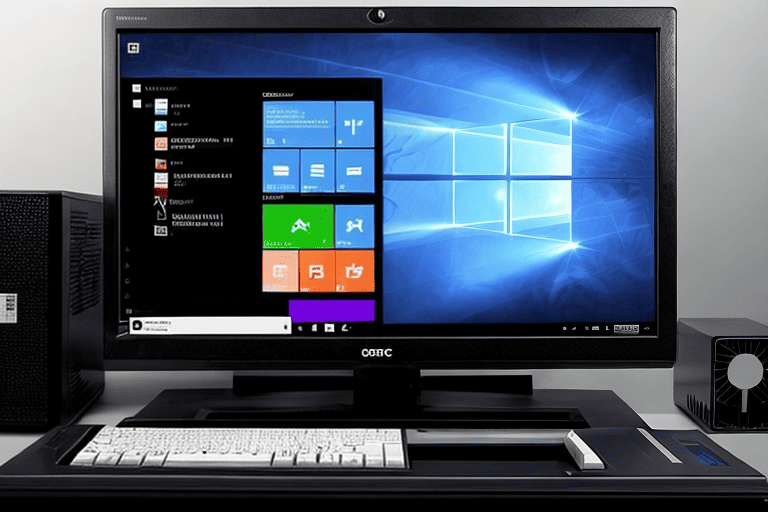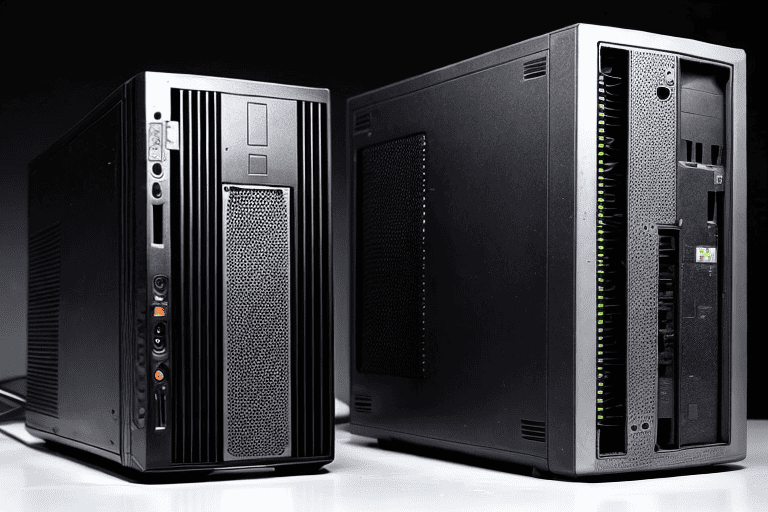
Dealing with computer blue screen errors can be incredibly frustrating and disruptive to both your work and leisure time. Understanding the common error codes and their corresponding solutions can help you tackle these issues more effectively.
One of the most frequently encountered blue screen errors is the STOP 0x0000007B error, which typically indicates an issue with your computer’s hard drive or storage system.
To resolve this error, you can inspect the connections of your hard drive, update device drivers, or perform a disk check to identify and fix any disk errors.
Another commonly seen error is the STOP 0x00000024 or NTFS_FILE_SYSTEM error, which suggests a problem with your computer’s file system. Running the Windows built-in tool called Check Disk can help identify and resolve this issue.
(Note: Please remember to implement the provided writing style guidelines when updating the article section. ) The blue screen of death appeared, indicating a severe computer crash that would require extensive troubleshooting and possibly computer repair to resolve the underlying issues.
Click here to learn more about computers, computer repair, and technology
Most Common Blue Screen Error Codes
The frustration and confusion that come with blue screen errors can be overwhelming for computer users. These stop codes, displayed on a blue screen, indicate critical errors that the operating system cannot recover from.
By understanding the most typical blue screen codes, users can effectively troubleshoot and resolve these issues.
One of these we’ll-known error codes is the STOP 0x0000007B code, pointing to an inaccessible boot device.
This error occurs when the computer cannot access the system partition or the hard drive. To resolve this issue, users should check their hard drive connections and run diagnostic tools to identify and fix any hardware or software problems.

Fixing Computer Blue Screen Errors
When it comes to fixing computer blue screen errors, it’s important to understand that these issues can have various causes. They can be the result of hardware problems like faulty RAM or incompatible graphics cards, or software conflicts.
To effectively resolve these errors, it’s crucial to identify the specific error code displayed on the screen as each code corresponds to a particular issue.
Common codes include IRQL_NOT_LESS_OR_EQUAL, PAGE_FAULT_IN_NONPAGED_AREA, and SYSTEM_SERVICE_EXCEPTION. Once the code is determined, users can start troubleshooting by examining and testing their hardware components, such as the RAM and hard drives.
Understanding Computer Error Codes
When encountering a computer error code, it is crucial to understand the common issues that can lead to these failures. Whether it’s a hardware malfunction or a software conflict, familiarizing oneself with the error codes can help in troubleshooting and finding suitable solutions.
To interpret these codes, it is vital to comprehend their meanings and explanations.
Many computer manufacturers and software developers provide comprehensive documentation that outlines the possible fixes for each code.
By referring to this documentation, users and technicians can quickly identify the root cause of the problem and implement the necessary solutions.
it’s important to note that error codes can vary depending on the operating system and software being used.
Each operating system, such as Windows, macOS, and Linux, has it’s unique set of codes. Therefore, it is essential to consult the appropriate documentation for the specific operating system or software in question.
Troubleshooting Blue Screen Errors
One vital element of troubleshooting blue screen errors is identifying the specific error codes associated with the problem. These codes act as important indicators that can assist in pinpointing the root cause of the issue.
Understanding these codes allows users to narrow down their troubleshooting efforts and focus on the most relevant solutions.
Whether you require troubleshooting, assistance, or support for computer error codes, decoding these error codes is essential for effectively resolving blue screen errors.
At our company, we provide the necessary expertise and assistance to help you resolve these errors promptly and efficiently.
Facts about Troubleshooting Blue Screen Errors
- Identifying specific error codes is crucial in troubleshooting blue screen errors.
- Error codes serve as important indicators to pinpoint the root cause of the problem.
- Understanding these codes helps narrow down troubleshooting efforts and focus on relevant solutions.
- Decoding error codes is essential for effectively resolving blue screen errors.
Resolving Blue Screen Crashes
When it comes to resolving blue screen crashes, one important aspect to consider is identifying the specific error codes linked to the crashes. These codes serve as valuable clues that aid in determining the underlying cause of the problem, allowing users to implement targeted remedies.
By thoroughly analyzing the error codes, users can effectively narrow down potential causes and apply appropriate fixes.
Understanding these error codes is crucial in successfully resolving blue screen crashes as it enables users to prioritize troubleshooting steps and find customized solutions for their issues.
Effective Solutions for Blue Screen Issues
Blue screen errors can be incredibly frustrating, but fortunately, there are effective solutions available to help resolve them. One of the most common causes of these errors is faulty hardware or drivers that are not compatible with your operating system.
To ensure compatibility and functionality, it is important to regularly update your drivers.
Software conflicts and malware infections are another frequent cause of blue screen errors.
These issues disrupt the stability of your system, leading to these frustrating errors. To address this, we recommend running a thorough antivirus scan and removing any suspicious software.
Insufficient system memory or disk space can also contribute to blue screen errors. If your computer is low on memory or disk space, it may struggle to perform tasks effectively.
To avoid this, make sure to free up space and manage your system resources properly.
Preventing Future Blue Screen Errors
In order to minimize the occurrence of blue screen errors, it is important to be proactive in maintaining a stable and efficient computer system. These frustrating and disruptive errors, commonly referred to as the Blue Screen of Death (BSOD), can result in data loss and system crashes.
By implementing effective strategies and solutions, you can prevent future occurrences and ensure smooth computing.
One crucial measure is regularly updating your operating system and device drivers.
Outdated software and drivers can lead to compatibility issues and system errors. By staying current with the latest bug fixes and security patches, you can reduce the chances of encountering these errors.
Another essential step is to install reliable antivirus software. Malware and viruses can cause havoc on your system, including blue screen errors and other problems.
A trusted antivirus software can offer essential protection, minimizing the risk of encountering the BSOD.
Essential Steps to Diagnose Error Codes
To effectively diagnose error codes and resolve any issues you may be facing on your computer, it is important to follow a systematic approach. Understanding the nature of the error code is the first step towards finding a solution.
Each error code corresponds to a specific problem within your system, and deciphering it can provide valuable insights.
Researching the specific error code you are encountering is crucial.
Online forums, knowledge bases, and official documentation related to the software or hardware involved can be great resources for finding typical causes and potential solutions for the error.
Once you have a better understanding of the error code, it’s time to start troubleshooting.
Begin by checking for any recent changes or updates that may have triggered the issue. This could include software installations, driver updates, or hardware modifications.
Undoing or updating these changes can often resolve the issue.
If the problem persists, gather additional information by noting the error message, any accompanying error codes, and any recent actions you have taken that may have contributed to the issue.
Diagnosing Computer Error Codes
- Understanding the nature of the error code is crucial for finding a solution.
- Researching the specific error code can provide valuable insights into typical causes and potential solutions.
- Checking for recent changes or updates that may have triggered the issue is an important troubleshooting step.
- Gathering additional information, such as error messages and recent actions, can help in resolving the problem.
Expert Advice for Resolving Blue Screen Crashes
Be a reason for blue screen crashes. It is important to ensure that all your device drivers are up to date.
This can usually be done by visiting the manufacturers website and downloading the latest driver versions for your hardware.
Installing these updated drivers can often resolve compatibility issues and prevent blue screen crashes from occurring.
In addition to hardware and driver issues, software conflicts can also lead to blue screen crashes. If you have recently installed any new software or made changes to your system settings, it may be worth uninstalling or reverting these changes to see if the crashes persist.
You can also use system restore points to roll back your computer to a previous state where it was functioning properly.
Another helpful step in troubleshooting blue screen crashes is performing a malware scan.
Malware infections can cause system instability and lead to crashes. Running a reputable antivirus or anti-malware program can help you identify and fix computer crashes.
Importance of Error Code Management in Computer Troubleshooting
Proper error code management is of utmost importance when it comes to troubleshooting computer issues. These error codes act as a language that technicians use to communicate with the system and identify the underlying cause of problems.
By effectively managing these codes, technicians can streamline the troubleshooting process, minimizing downtime and creating a comprehensive knowledge base for efficient solutions and preventive measures.
Error code management facilitates accurate communication between technicians and software developers, resulting in improved system stability and performance.
It plays a crucial role in addressing computer crash problems and ensuring smooth operations.
Error Code Management
- Proper error code management allows technicians to efficiently troubleshoot computer issues.
- By effectively managing error codes, technicians can minimize downtime and optimize the troubleshooting process.
- Error code management helps create a comprehensive knowledge base for efficient solutions and preventive measures.
- Accurate communication between technicians and software developers, facilitated by error code management, improves system stability and performance.
Steps to Fix External Hard Drives Not Showing Up on PCs
Resolving Annoying Windows PC Crashes, Freezes and BSODs
